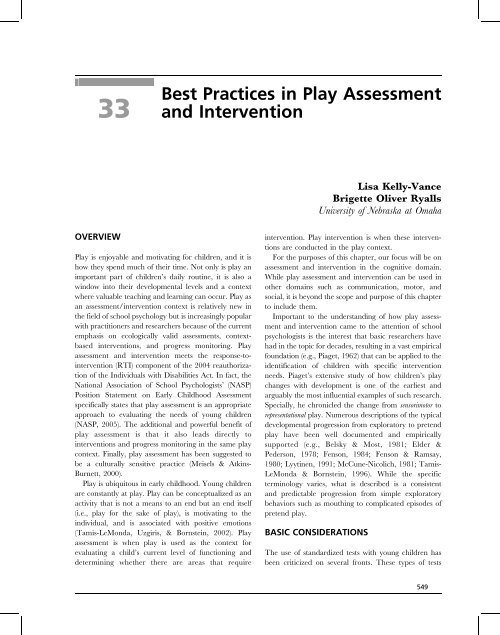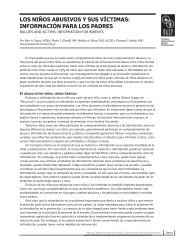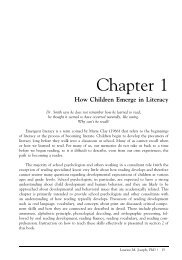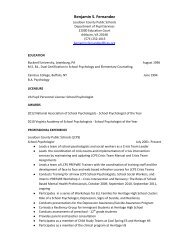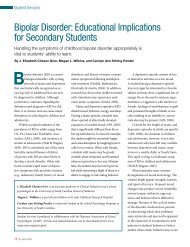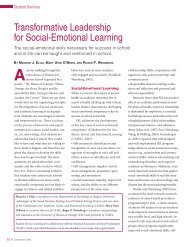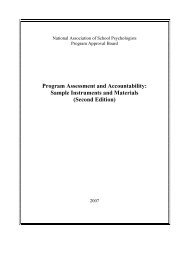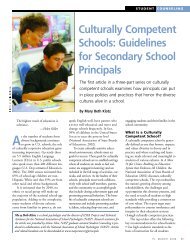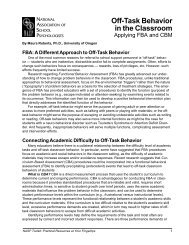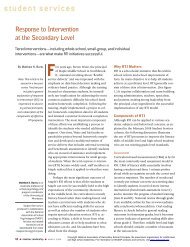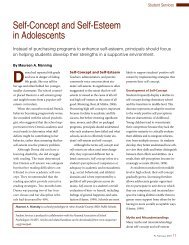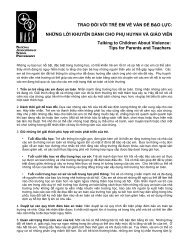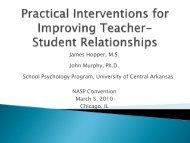Best Practices in Play Assessment and Intervention
Best Practices in Play Assessment and Intervention
Best Practices in Play Assessment and Intervention
You also want an ePaper? Increase the reach of your titles
YUMPU automatically turns print PDFs into web optimized ePapers that Google loves.
33<br />
OVERVIEW<br />
<strong>Best</strong> <strong>Practices</strong> <strong>in</strong> <strong>Play</strong> <strong>Assessment</strong><br />
<strong>and</strong> <strong>Intervention</strong><br />
<strong>Play</strong> is enjoyable <strong>and</strong> motivat<strong>in</strong>g for children, <strong>and</strong> it is<br />
how they spend much of their time. Not only is play an<br />
important part of children’s daily rout<strong>in</strong>e, it is also a<br />
w<strong>in</strong>dow <strong>in</strong>to their developmental levels <strong>and</strong> a context<br />
where valuable teach<strong>in</strong>g <strong>and</strong> learn<strong>in</strong>g can occur. <strong>Play</strong> as<br />
an assessment/<strong>in</strong>tervention context is relatively new <strong>in</strong><br />
the field of school psychology but is <strong>in</strong>creas<strong>in</strong>gly popular<br />
with practitioners <strong>and</strong> researchers because of the current<br />
emphasis on ecologically valid assessments, contextbased<br />
<strong>in</strong>terventions, <strong>and</strong> progress monitor<strong>in</strong>g. <strong>Play</strong><br />
assessment <strong>and</strong> <strong>in</strong>tervention meets the response-to<strong>in</strong>tervention<br />
(RTI) component of the 2004 reauthorization<br />
of the Individuals with Disabilities Act. In fact, the<br />
National Association of School Psychologists’ (NASP)<br />
Position Statement on Early Childhood <strong>Assessment</strong><br />
specifically states that play assessment is an appropriate<br />
approach to evaluat<strong>in</strong>g the needs of young children<br />
(NASP, 2005). The additional <strong>and</strong> powerful benefit of<br />
play assessment is that it also leads directly to<br />
<strong>in</strong>terventions <strong>and</strong> progress monitor<strong>in</strong>g <strong>in</strong> the same play<br />
context. F<strong>in</strong>ally, play assessment has been suggested to<br />
be a culturally sensitive practice (Meisels & Atk<strong>in</strong>s-<br />
Burnett, 2000).<br />
<strong>Play</strong> is ubiquitous <strong>in</strong> early childhood. Young children<br />
are constantly at play. <strong>Play</strong> can be conceptualized as an<br />
activity that is not a means to an end but an end itself<br />
(i.e., play for the sake of play), is motivat<strong>in</strong>g to the<br />
<strong>in</strong>dividual, <strong>and</strong> is associated with positive emotions<br />
(Tamis-LeMonda, Uzgiris, & Bornste<strong>in</strong>, 2002). <strong>Play</strong><br />
assessment is when play is used as the context for<br />
evaluat<strong>in</strong>g a child’s current level of function<strong>in</strong>g <strong>and</strong><br />
determ<strong>in</strong><strong>in</strong>g whether there are areas that require<br />
Lisa Kelly-Vance<br />
Brigette Oliver Ryalls<br />
University of Nebraska at Omaha<br />
<strong>in</strong>tervention. <strong>Play</strong> <strong>in</strong>tervention is when these <strong>in</strong>terventions<br />
are conducted <strong>in</strong> the play context.<br />
For the purposes of this chapter, our focus will be on<br />
assessment <strong>and</strong> <strong>in</strong>tervention <strong>in</strong> the cognitive doma<strong>in</strong>.<br />
While play assessment <strong>and</strong> <strong>in</strong>tervention can be used <strong>in</strong><br />
other doma<strong>in</strong>s such as communication, motor, <strong>and</strong><br />
social, it is beyond the scope <strong>and</strong> purpose of this chapter<br />
to <strong>in</strong>clude them.<br />
Important to the underst<strong>and</strong><strong>in</strong>g of how play assessment<br />
<strong>and</strong> <strong>in</strong>tervention came to the attention of school<br />
psychologists is the <strong>in</strong>terest that basic researchers have<br />
had <strong>in</strong> the topic for decades, result<strong>in</strong>g <strong>in</strong> a vast empirical<br />
foundation (e.g., Piaget, 1962) that can be applied to the<br />
identification of children with specific <strong>in</strong>tervention<br />
needs. Piaget’s extensive study of how children’s play<br />
changes with development is one of the earliest <strong>and</strong><br />
arguably the most <strong>in</strong>fluential examples of such research.<br />
Specially, he chronicled the change from sensorimotor to<br />
representational play. Numerous descriptions of the typical<br />
developmental progression from exploratory to pretend<br />
play have been well documented <strong>and</strong> empirically<br />
supported (e.g., Belsky & Most, 1981; Elder &<br />
Pederson, 1978; Fenson, 1984; Fenson & Ramsay,<br />
1980; Lyyt<strong>in</strong>en, 1991; McCune-Nicolich, 1981; Tamis-<br />
LeMonda & Bornste<strong>in</strong>, 1996). While the specific<br />
term<strong>in</strong>ology varies, what is described is a consistent<br />
<strong>and</strong> predictable progression from simple exploratory<br />
behaviors such as mouth<strong>in</strong>g to complicated episodes of<br />
pretend play.<br />
BASIC CONSIDERATIONS<br />
The use of st<strong>and</strong>ardized tests with young children has<br />
been criticized on several fronts. These types of tests<br />
549
<strong>Best</strong> <strong>Practices</strong> <strong>in</strong> School Psychology V<br />
serve eligibility purposes but do not provide <strong>in</strong>formation<br />
about how to develop or monitor appropriate <strong>in</strong>terventions,<br />
they are not ecologically valid <strong>and</strong> do not assess<br />
the child <strong>in</strong> the natural context, <strong>and</strong> they are a<br />
potentially unmotivat<strong>in</strong>g <strong>and</strong> <strong>in</strong>appropriate means of<br />
gather<strong>in</strong>g valid <strong>in</strong>formation about a young child (Kelly-<br />
Vance & Ryalls, 2005). Further, many practitioners<br />
have expressed misgiv<strong>in</strong>gs about the use of tests to<br />
determ<strong>in</strong>e young children’s current level of performance<br />
(Barnett, Macmann, & Carey, 1992) <strong>and</strong> would prefer to<br />
use alternative strategies such as play assessment<br />
(Bagnato & Neisworth, 1994).<br />
The orig<strong>in</strong>s of play assessment <strong>and</strong> <strong>in</strong>tervention<br />
stem from psychoanalytic work with children at the<br />
turn of the twentieth century. Therapists used <strong>in</strong>formation<br />
from children’s play to determ<strong>in</strong>e their mental<br />
health needs <strong>and</strong> then used the play context dur<strong>in</strong>g<br />
therapy. This practice cont<strong>in</strong>ues <strong>in</strong> many different<br />
therapeutic approaches. More recently <strong>and</strong> for the<br />
reasons discussed above, school psychologists work<strong>in</strong>g <strong>in</strong><br />
early childhood began us<strong>in</strong>g play assessment as an<br />
observational strategy <strong>in</strong> the 1980s (as discussed <strong>in</strong><br />
Athanasiou, 2007). L<strong>in</strong>der (1990) brought even more<br />
attention to the procedures with the publication of<br />
her play assessment model <strong>and</strong> her subsequent play<br />
<strong>in</strong>tervention model (L<strong>in</strong>der, 1993a, 1993b). Practitioners<br />
have been us<strong>in</strong>g play assessment <strong>and</strong> <strong>in</strong>tervention, but<br />
the empirical support for its use has only recently<br />
emerged (e.g., Cherney, Kelly-Vance, Gill-Glover,<br />
Ruane, & Ryalls, 2003; Farmer-Dougan & Kaszuba,<br />
1999; Kelly-Vance, Needelman, Troia, & Ryalls, 1999;<br />
Kelly-Vance & Ryalls, 2005; Kelly-Vance, Ryalls, &<br />
Gill-Glover, 2002; Myers, McBride, & Peterson, 1996).<br />
Fortunately, studies are confirm<strong>in</strong>g what practitioners<br />
have known <strong>in</strong>tuitively, which is that this approach is a<br />
reliable <strong>and</strong> valid means of assess<strong>in</strong>g young children (see<br />
below). Moreover, the assessment procedures can be<br />
used regularly to monitor the progress of children<br />
receiv<strong>in</strong>g <strong>in</strong>terventions.<br />
Tra<strong>in</strong><strong>in</strong>g <strong>and</strong> Equipment<br />
While the specific materials <strong>and</strong> procedures required for<br />
different versions of play assessment <strong>and</strong> <strong>in</strong>tervention<br />
vary, all forms are similar enough that general guidel<strong>in</strong>es<br />
concern<strong>in</strong>g equipment <strong>and</strong> tra<strong>in</strong><strong>in</strong>g can be provided.<br />
With regard to equipment, one of the advantages of play<br />
assessment <strong>and</strong> <strong>in</strong>tervention is that no specialized<br />
materials, forms, or equipment are required. All types<br />
of play assessment <strong>and</strong> <strong>in</strong>tervention <strong>in</strong>volve children<br />
play<strong>in</strong>g with toys or other play materials (e.g., crayons<br />
<strong>and</strong> paper). While some forms of play assessment do<br />
require a particular set of play objects (e.g., Fewell as<br />
cited <strong>in</strong> Athanasiou, 2007), others can be conducted <strong>in</strong><br />
any toy room or early childhood classroom (e.g., Kelly-<br />
Vance & Ryalls, 2005; L<strong>in</strong>der, 1993a; Ryalls et al.,<br />
2000) as long as the available toys are diverse enough to<br />
elicit a wide range of play behaviors, <strong>in</strong>clud<strong>in</strong>g complex<br />
pretend play, <strong>and</strong> are attractive to both boys <strong>and</strong> girls.<br />
Some specific considerations regard<strong>in</strong>g toy choice will<br />
be discussed below.<br />
Although no specialized equipment is necessary to<br />
conduct play assessments or <strong>in</strong>terventions, some tra<strong>in</strong><strong>in</strong>g<br />
<strong>and</strong> experience is necessary; however, the nature of this<br />
tra<strong>in</strong><strong>in</strong>g depends on the RTI tier <strong>in</strong> question. Certa<strong>in</strong>ly,<br />
knowledge about child development <strong>in</strong> general, <strong>and</strong> the<br />
developmental course of play <strong>in</strong> particular, is necessary<br />
at all three RTI tier levels. A thorough underst<strong>and</strong><strong>in</strong>g of<br />
a tiered RTI system <strong>and</strong> the specific problem-solv<strong>in</strong>g<br />
approach used with children who have more <strong>in</strong>tense<br />
needs is necessary <strong>in</strong> utiliz<strong>in</strong>g play assessment to guide<br />
the <strong>in</strong>tervention process. With regard to the <strong>in</strong>formal<br />
assessments that occur at Tier 1, the school psychologist<br />
needs to make sure the personnel <strong>and</strong> parents <strong>in</strong>volved<br />
have a general underst<strong>and</strong><strong>in</strong>g of how <strong>and</strong> when play<br />
changes with development. At Tier 2 or 3, most forms of<br />
play assessment can be considered observational cod<strong>in</strong>g<br />
systems, <strong>and</strong> thus some experience us<strong>in</strong>g such systems is<br />
beneficial. Familiarity with the specific cod<strong>in</strong>g system is<br />
obviously required, as is some tra<strong>in</strong><strong>in</strong>g <strong>and</strong> experience<br />
identify<strong>in</strong>g particular examples of success or failure or<br />
assign<strong>in</strong>g specific codes to play behaviors (e.g., substitution).<br />
As with any observational cod<strong>in</strong>g system, such<br />
experience is necessary to ensure the reliability of the<br />
assessment across observers <strong>and</strong> across play sessions<br />
(Salvia, Ysseldyke, & Bolt, 2007). The nature <strong>and</strong><br />
amount of tra<strong>in</strong><strong>in</strong>g depends on the particular form of<br />
play assessment <strong>in</strong>volved. With respect to the type of<br />
tra<strong>in</strong><strong>in</strong>g required for actual <strong>in</strong>tervention implementation,<br />
all <strong>in</strong>terventions are grounded <strong>in</strong> the context of<br />
play <strong>and</strong> thus require no specialized education or<br />
tra<strong>in</strong><strong>in</strong>g above <strong>and</strong> beyond the specific <strong>in</strong>terventions<br />
themselves.<br />
BEST PRACTICES<br />
Types of <strong>Play</strong> <strong>Assessment</strong><br />
Unlike other forms of early childhood assessment,<br />
relatively little activity has occurred <strong>in</strong> the development<br />
of play assessment techniques. Of those that exist, only<br />
three have been described <strong>in</strong> enough detail to use <strong>in</strong><br />
550 Chapter 33, Volume 2
practice. These three approaches are described <strong>in</strong> the<br />
follow<strong>in</strong>g section.<br />
<strong>Play</strong> <strong>Assessment</strong> Scale<br />
The <strong>Play</strong> <strong>Assessment</strong> Scale (PAS) is designed to evaluate<br />
the develop<strong>in</strong>g skills of children from 2 to 36 months<br />
(Fewell as cited <strong>in</strong> Athanasiou, 2007). This 45-item scale<br />
is developmentally sequenced <strong>and</strong> is organized <strong>in</strong>to eight<br />
age ranges <strong>and</strong> toy sets so that only a portion of the<br />
items are rated for each child. Children are first<br />
observed <strong>in</strong> spontaneous play followed by a facilitated<br />
play session, <strong>and</strong> their play behaviors are coded<br />
accord<strong>in</strong>g to the scale so that a play age can be<br />
determ<strong>in</strong>ed. The play age is composed only of those<br />
behaviors observed <strong>in</strong> spontaneous play. A basal/ceil<strong>in</strong>g<br />
approach is used <strong>and</strong> a conversion chart allows the rater<br />
to convert the raw score to the child’s play age. Anyone<br />
familiar with the PAS can adm<strong>in</strong>ister the items <strong>and</strong><br />
complete the rat<strong>in</strong>g scale, but Fewell stresses that the<br />
<strong>in</strong>dividual rat<strong>in</strong>g the child must thoroughly underst<strong>and</strong><br />
the <strong>in</strong>dividual PAS items <strong>and</strong> the play behaviors that<br />
would justify that a child possesses the skill reflected <strong>in</strong><br />
each item.<br />
Transdiscipl<strong>in</strong>ary <strong>Play</strong>-Based <strong>Assessment</strong><br />
The most thoroughly described play assessment technique,<br />
Transdiscipl<strong>in</strong>ary <strong>Play</strong>-Based <strong>Assessment</strong><br />
(TPBA), was developed by L<strong>in</strong>der (1990, 1993a). Her<br />
transdiscipl<strong>in</strong>ary approach captures the essence of<br />
collaboration <strong>in</strong> that early childhood service providers<br />
<strong>and</strong> parents work together to f<strong>in</strong>d out <strong>in</strong>formation about<br />
a child’s developmental levels <strong>and</strong> l<strong>in</strong>k it directly to<br />
<strong>in</strong>terventions. The team approach is conducted <strong>in</strong> what<br />
she called an ‘‘arena’’ format where <strong>in</strong>dividuals from<br />
various discipl<strong>in</strong>es observe the child <strong>in</strong> free play <strong>and</strong><br />
document the play behaviors. The adults communicate<br />
their f<strong>in</strong>d<strong>in</strong>gs with one another throughout the observational<br />
period allow<strong>in</strong>g for a shared perspective on the<br />
child’s skill level.<br />
General guidel<strong>in</strong>es for conduct<strong>in</strong>g the data gather<strong>in</strong>g<br />
sessions were published <strong>in</strong> her ground-break<strong>in</strong>g book<br />
(L<strong>in</strong>der, 1990). Prior to the play session, the professionals<br />
contact the child’s caregiver to f<strong>in</strong>d out their<br />
concerns <strong>and</strong> prelim<strong>in</strong>ary <strong>in</strong>formation on the child’s<br />
function<strong>in</strong>g. The structure of the session takes <strong>in</strong>to<br />
account any <strong>in</strong>formation obta<strong>in</strong>ed from the parents.<br />
The observational team consists of a play facilitator who<br />
engages with the child, a parent facilitator who is<br />
responsible for discuss<strong>in</strong>g the process with the parent(s),<br />
<strong>Play</strong> <strong>Assessment</strong> <strong>and</strong> <strong>Intervention</strong><br />
the evaluators, <strong>and</strong> a person to operate the video<br />
camera. A large play area such as a classroom is<br />
recommended for the session, but any sett<strong>in</strong>g with a<br />
variety of toys can be used. Initially, the child<br />
plays alone <strong>and</strong> no structure is imposed upon the<br />
activities. The play facilitator can participate but not<br />
<strong>in</strong>itiate any of the play. Facilitation occurs <strong>in</strong> the<br />
second phase where the adult attempts to engage<br />
the child <strong>in</strong> activities that have not yet been observed<br />
<strong>and</strong> may be <strong>in</strong> the child’s repertoire. It is essentially a<br />
test<strong>in</strong>g phase. Follow<strong>in</strong>g the two phases <strong>in</strong>volv<strong>in</strong>g<br />
adults, the child is then observed play<strong>in</strong>g with<br />
another child <strong>and</strong> then <strong>in</strong>teract<strong>in</strong>g with a parent. A<br />
phase of motor play then occurs adher<strong>in</strong>g to the<br />
same sequence as the <strong>in</strong>itial play activities. The session<br />
ends with a snack, <strong>and</strong> feedback is provided to the<br />
parent(s). The entire session lasts between 60 <strong>and</strong> 90<br />
m<strong>in</strong>utes.<br />
Unique to the L<strong>in</strong>der model are the detailed cod<strong>in</strong>g<br />
guidel<strong>in</strong>es. She provides developmental cod<strong>in</strong>g schemes<br />
for cognitive, social–emotional, communication <strong>and</strong><br />
language, <strong>and</strong> sensorimotor development. The applicable<br />
ages vary, but, <strong>in</strong> general, the cod<strong>in</strong>g guidel<strong>in</strong>es<br />
apply to young children up to 60–72 months of age.<br />
Each general category of development (e.g., cognition,<br />
communication, motor skills) is subdivided <strong>in</strong>to more<br />
specific categories labeled subdoma<strong>in</strong>s. These cod<strong>in</strong>g<br />
guidel<strong>in</strong>es are used to describe a child’s strengths <strong>and</strong><br />
their area of <strong>in</strong>tervention need. Specific suggestions for<br />
<strong>in</strong>tervention are derived from the assessment results<br />
(L<strong>in</strong>der, 1993b).<br />
<strong>Play</strong> <strong>in</strong> Early Childhood Evaluation System<br />
The <strong>Play</strong> <strong>in</strong> Early Childhood Evaluation System<br />
(PIECES) is the most recently developed <strong>and</strong> extensively<br />
<strong>in</strong>vestigated approach to play assessment (Cherney et<br />
al., 2003; Kelly-Vance, Gill, Ruane, Cherney, & Ryalls,<br />
1999; Kelly-Vance, Needleman, et al., 1999; Kelly-<br />
Vance & Ryalls, 2005; Kelly-Vance et al., 2002; Ryalls<br />
et al., 2000). The PIECES grew out of empirical work<br />
orig<strong>in</strong>ally based on L<strong>in</strong>der’s TPBA cognitive development<br />
assessment guidel<strong>in</strong>es. The PIECES approach is<br />
both similar to <strong>and</strong> dissimilar from L<strong>in</strong>der’s TPBA<br />
approach. With regard to assessment procedures, like<br />
TBPA, the PIECES assessment <strong>in</strong>volves observation of a<br />
child engaged <strong>in</strong> free play. The PIECES is also similar to<br />
L<strong>in</strong>der’s TPBA <strong>in</strong> that the assessment can be conducted<br />
<strong>in</strong> any sett<strong>in</strong>g with any toy set as long as the toy set is<br />
large <strong>and</strong> varied enough to elicit a wide range of<br />
behaviors.<br />
Chapter 33, Volume 2 551
<strong>Best</strong> <strong>Practices</strong> <strong>in</strong> School Psychology V<br />
In the PIECES assessment, children play freely for<br />
30–45 m<strong>in</strong>utes <strong>and</strong> can be videoed. They are not<br />
required to produce any specific behaviors with any<br />
specific toys. The procedures are dissimilar from<br />
L<strong>in</strong>der’s TPBA <strong>in</strong> that the child usually plays alone<br />
<strong>and</strong> without any facilitation on the part of adult<br />
observers. Parents <strong>and</strong> a session facilitator are present<br />
<strong>and</strong> free to praise the child <strong>and</strong> to repeat what the child<br />
says, but are <strong>in</strong>structed not to ask questions or suggest<br />
new play behaviors. Because the PIECES focuses<br />
exclusively on cognitive development, a multidiscipl<strong>in</strong>ary<br />
team of observers, while certa<strong>in</strong>ly allowable, is not<br />
necessary.<br />
With regard to the cod<strong>in</strong>g guidel<strong>in</strong>es, L<strong>in</strong>der’s TPBA<br />
<strong>and</strong> the PIECES are similar <strong>in</strong> that the guidel<strong>in</strong>es are<br />
broken down <strong>in</strong>to multiple scales exam<strong>in</strong><strong>in</strong>g different<br />
doma<strong>in</strong>s of cognitive development, although the specific<br />
doma<strong>in</strong>s differ. The PIECES cod<strong>in</strong>g scheme conta<strong>in</strong>s<br />
one core subdoma<strong>in</strong> (exploratory/pretend play) as well<br />
as several supplemental subdoma<strong>in</strong>s (see Table 1). The<br />
supplemental subdoma<strong>in</strong>s (e.g., problem-solv<strong>in</strong>g skills<br />
<strong>and</strong> plann<strong>in</strong>g, categorization, quantitative skills) are<br />
adapted versions of several of L<strong>in</strong>der’s subscales.<br />
The PIECES cod<strong>in</strong>g guidel<strong>in</strong>es differ from TPBA <strong>in</strong><br />
that the 13-item sequence that makes up the exploratory/pretend<br />
play core subdoma<strong>in</strong> was drawn not from<br />
L<strong>in</strong>der but <strong>in</strong>stead from the extensive empirical<br />
literature on the development of play (Belsky & Most,<br />
1981; Fenson, 1984, Lyyt<strong>in</strong>en, 1991; Tamis-LeMonda,<br />
Bornste<strong>in</strong>, Cyphers, Toda, & Og<strong>in</strong>o, 1992). In the<br />
PIECES cod<strong>in</strong>g system, every play behavior produced<br />
by the child can be classified on the core subdoma<strong>in</strong><br />
whereas the supplemental subdoma<strong>in</strong>s are reserved for<br />
specific types of behaviors (such as trial-<strong>and</strong>-error<br />
problem solv<strong>in</strong>g, sort<strong>in</strong>g, <strong>and</strong> draw<strong>in</strong>g), which may or<br />
may not occur <strong>in</strong> any given play session. The<br />
<strong>in</strong>formation obta<strong>in</strong>ed from this cod<strong>in</strong>g procedure is<br />
then compared to norms for typically develop<strong>in</strong>g<br />
children to determ<strong>in</strong>e if the child has specific areas that<br />
require <strong>in</strong>tervention. <strong>Intervention</strong>s are targeted at the<br />
core <strong>and</strong>/or supplemental subdoma<strong>in</strong> skills found to be<br />
discrepant from peers.<br />
Research on <strong>Play</strong> <strong>Assessment</strong><br />
Emerg<strong>in</strong>g evidence for the validity of various forms of<br />
play assessment has been reported <strong>in</strong> several studies.<br />
Support for the validity of PAS was established by Eisert<br />
<strong>and</strong> Lamorey (1996), Fewell <strong>and</strong> Rich (1987), <strong>and</strong> F<strong>in</strong>n<br />
<strong>and</strong> Fewell (1994). In these studies, PAS was found to<br />
correlate with st<strong>and</strong>ardized <strong>and</strong> nonst<strong>and</strong>ardized measures<br />
of cognition, communication, motor skills, <strong>and</strong><br />
adaptive behavior. Two published studies have reported<br />
on the validity of L<strong>in</strong>der’s TPBA model. The Myers et<br />
al. (1996) study of social validity found that parents <strong>and</strong><br />
early childhood professionals preferred TPBA model to<br />
more traditional <strong>in</strong>formation yielded from st<strong>and</strong>ardized<br />
tests. Kelly-Vance, Needelman, et al. (1999) found a<br />
high correlation between scores from the Bayley Scales<br />
of Infant Development II <strong>and</strong> the cognitive development<br />
guidel<strong>in</strong>es from L<strong>in</strong>der’s TPBA. In addition, one<br />
unpublished dissertation exam<strong>in</strong>ed the concurrent <strong>and</strong><br />
content validity <strong>and</strong> the test–retest <strong>and</strong> <strong>in</strong>terrater<br />
reliability of TPBA <strong>and</strong> found it adequate (Friedli as<br />
cited <strong>in</strong> Athanasiou, 2007). A study of a more general<br />
form of play assessment found adequate validity when<br />
compar<strong>in</strong>g a brief play assessment scale to measures of<br />
development (Farmer-Dougan & Kaszuba, 1999).<br />
Thus, while there is a smatter<strong>in</strong>g of publications<br />
on play assessment measures, much more work needs<br />
to be conducted to meet the current st<strong>and</strong>ards of<br />
reliability <strong>and</strong> validity, particularly <strong>in</strong> light of the<br />
fact that such techniques are explicitly listed as an<br />
alternative assessment method <strong>in</strong> the NASP Position<br />
Statement on Early Childhood <strong>Assessment</strong> (NASP,<br />
2005).<br />
Table 1. Core Subdoma<strong>in</strong> <strong>and</strong> Supplemental Subdoma<strong>in</strong>s Assessed <strong>in</strong> PIECES<br />
Subdoma<strong>in</strong> Levels Description<br />
Core<br />
. Exploratory/pretend play 13 Ranges from mouth<strong>in</strong>g <strong>and</strong> simple manipulation to extended sequences of pretense<br />
Supplemental<br />
. Problem-solv<strong>in</strong>g skills <strong>and</strong> plann<strong>in</strong>g 12 Ranges from simple search for a hidden object to complex means-end problem solv<strong>in</strong>g<br />
. Categorization skills 19 Ranges from simple comb<strong>in</strong>ations based on perceptual similarity to complex<br />
classification based on nonperceptual features<br />
. Quantitative skills 10 Ranges from count<strong>in</strong>g 1–5 to recogniz<strong>in</strong>g <strong>and</strong> label<strong>in</strong>g all numbers 0–9<br />
. Draw<strong>in</strong>g skills 21 Ranges from scribbl<strong>in</strong>g to draw<strong>in</strong>g <strong>and</strong>/or copy<strong>in</strong>g complex forms <strong>and</strong> shapes<br />
. Seriation abilities 11 Ranges from underst<strong>and</strong><strong>in</strong>g of basic dimension terms (e.g., big) to seriation of four<br />
or more objects<br />
552 Chapter 33, Volume 2
This lack of research motivated us to beg<strong>in</strong> a<br />
systematic exam<strong>in</strong>ation of the psychometric properties<br />
of play assessment. We began with the development of<br />
cod<strong>in</strong>g guidel<strong>in</strong>es. Our goals <strong>in</strong> the development of these<br />
guidel<strong>in</strong>es were to develop a system of assessment that<br />
would thoroughly evaluate a child’s skills <strong>in</strong> the cognitive<br />
doma<strong>in</strong>, would lead directly to the development of<br />
appropriate <strong>in</strong>terventions to be implemented <strong>in</strong> the<br />
context of play, <strong>and</strong> would easily allow for monitor<strong>in</strong>g<br />
the effectiveness of these <strong>in</strong>terventions.<br />
As discussed above, we began with the most popular<br />
form of play assessment, L<strong>in</strong>der’s TPBA, <strong>and</strong> adapted<br />
her cod<strong>in</strong>g guidel<strong>in</strong>es to <strong>in</strong>clude <strong>in</strong>formation drawn<br />
from extensive basic research on play. The result<strong>in</strong>g<br />
PIECES guidel<strong>in</strong>es have been evaluated empirically <strong>and</strong><br />
found to have high <strong>in</strong>terrater reliability (Kelly-Vance &<br />
Ryalls, 2005). In addition, this high <strong>in</strong>terrater reliability<br />
was achieved with a relatively simple tra<strong>in</strong><strong>in</strong>g procedure.<br />
That is, <strong>in</strong>dividuals with a background <strong>in</strong> observational<br />
techniques can be tra<strong>in</strong>ed to accurately <strong>and</strong> reliably use<br />
these guidel<strong>in</strong>es to assess play behavior with as little as a<br />
half day of tra<strong>in</strong><strong>in</strong>g (Kelly-Vance, Gill, et al., 1999;<br />
Kelly-Vance et al., 2000).<br />
In addition to work develop<strong>in</strong>g psychometrically<br />
sound cod<strong>in</strong>g guidel<strong>in</strong>es, we have also worked to<br />
develop a play assessment procedure that is both<br />
practical, from the perspective of practitioners <strong>and</strong><br />
families, as well as valid <strong>and</strong> reliable. Our procedure,<br />
aga<strong>in</strong> <strong>in</strong>itially based on L<strong>in</strong>der’s technique, was briefly<br />
described above. In develop<strong>in</strong>g this procedure, we have<br />
empirically exam<strong>in</strong>ed a number of session characteristics<br />
<strong>and</strong> identified a process that is effective as well as easily<br />
<strong>and</strong> accurately reproduced. We have <strong>in</strong>vestigated<br />
numerous procedural aspects <strong>in</strong>clud<strong>in</strong>g toy selection<br />
(Cherney et al., 2003), facilitation versus nonfacilitation<br />
(K<strong>in</strong>g, McCasl<strong>in</strong>, Kelly-Vance, & Ryalls, 2003), the<br />
familiarity of the context (Drobny, 2003), <strong>and</strong> the<br />
impact of the presence of a peer (Fredenberg, 2004;<br />
Mendez, 2005). We have also exam<strong>in</strong>ed other important<br />
attributes such as test–retest reliability (Kelly-Vance &<br />
Ryalls, 2005), correlations with other st<strong>and</strong>ardized<br />
measures (Fiscus, 2006), <strong>and</strong> use with special populations<br />
(Gill-Glover, McCasl<strong>in</strong>, Kelly-Vance, & Ryalls,<br />
2001; Johnson, 2005; Kelly-Vance, Needelman, et al.,<br />
1999).<br />
How to Conduct a <strong>Play</strong> <strong>Assessment</strong><br />
Because the PIECES is the only approach that has been<br />
empirically tested to this degree, we believe it to be best<br />
practice at this time. We have focused on develop<strong>in</strong>g a<br />
procedure that is both valid <strong>and</strong> reliable <strong>and</strong> is<br />
practitioner friendly. While we believe this method to<br />
be best practice, the model allows for flexibility <strong>in</strong><br />
ensur<strong>in</strong>g that the procedures are appropriate for each<br />
<strong>in</strong>dividual child. The basic structure described below<br />
should be used, but adaptations for specific referral<br />
concerns should be taken <strong>in</strong>to account.<br />
Session Characteristics<br />
<strong>Play</strong> <strong>Assessment</strong> <strong>and</strong> <strong>Intervention</strong><br />
Context<br />
One of the many positive characteristics of play<br />
assessment is that it can be conducted <strong>in</strong> a variety of<br />
sett<strong>in</strong>gs such as home, daycare, preschool, or laboratory.<br />
We have consistent results when play assessments<br />
conducted <strong>in</strong> the home were compared to those <strong>in</strong> a<br />
laboratory sett<strong>in</strong>g (Drobny, 2003); however, the child’s<br />
comfort level should be considered when select<strong>in</strong>g the<br />
location <strong>and</strong> <strong>in</strong>terpret<strong>in</strong>g the f<strong>in</strong>d<strong>in</strong>gs.<br />
Selection <strong>and</strong> Organization of Toys<br />
When select<strong>in</strong>g toys for play assessment it is important<br />
to make sure that the toys are appropriate for the age,<br />
assumed developmental level, <strong>and</strong> gender of the child<br />
be<strong>in</strong>g assessed. While it is commonly recognized that<br />
children of different ages/developmental levels may<br />
choose to play with different types of toys, it is important<br />
to keep <strong>in</strong> m<strong>in</strong>d that boys <strong>and</strong> girls also have preferences<br />
<strong>and</strong> these preferences may have an impact on the<br />
outcome of the assessment. By 2 years of age, children<br />
display preferences for certa<strong>in</strong> types of toys (O’Brien &<br />
Huston, 1985). That is, boys <strong>and</strong> girls tend to prefer to<br />
play with toys that are stereotypically consistent with<br />
their own gender. While both boys <strong>and</strong> girls show this<br />
tendency, research has shown that this tendency is more<br />
pronounced for boys (Cherney et al., 2003). Specifically,<br />
Cherney <strong>and</strong> colleagues found that while boys played<br />
with predom<strong>in</strong>antly male stereotyped toys (e.g., cars <strong>and</strong><br />
trucks), girls played predom<strong>in</strong>antly with neutral toys<br />
(e.g., puzzles <strong>and</strong> cash register). More importantly, for<br />
both boys <strong>and</strong> girls, it was found that the male<br />
stereotyped toys elicited the simplest forms of play <strong>and</strong><br />
the female stereotyped toys (e.g., dolls <strong>and</strong> kitchen set)<br />
elicited the highest levels of play. Thus, when conduct<strong>in</strong>g<br />
a play assessment the school psychologist should<br />
ensure that a variety of toys that are gender appropriate<br />
are available <strong>and</strong> encourage children to play with toys<br />
that have the potential to elicit more complex forms of<br />
play.<br />
In addition to the types of toys present, the<br />
arrangement of the toys must also be considered. For<br />
Chapter 33, Volume 2 553
<strong>Best</strong> <strong>Practices</strong> <strong>in</strong> School Psychology V<br />
the purposes of play assessment, it is important that all<br />
toys are visible <strong>and</strong> accessible to the child. In addition,<br />
similar toys (e.g., dolls <strong>and</strong> doll-related toys) should be<br />
grouped together to encourage thematic play. F<strong>in</strong>ally,<br />
while the playroom should be neatly organized, it need<br />
not be prist<strong>in</strong>e, <strong>and</strong>, <strong>in</strong> fact, a mild level of disarray may<br />
be helpful to encourage certa<strong>in</strong> types of behaviors.<br />
Specifically, problem-solv<strong>in</strong>g behavior is often observed<br />
when children attempt to assemble puzzles <strong>and</strong><br />
construct tra<strong>in</strong> tracks, so leav<strong>in</strong>g them somewhat<br />
unassembled is recommended.<br />
Facilitated Versus Nonfacilitated <strong>Play</strong><br />
Some play assessment approaches <strong>in</strong>volve significant<br />
levels of facilitation <strong>and</strong>/or model<strong>in</strong>g, often requir<strong>in</strong>g<br />
the reproduction of very specific play behaviors. We<br />
believe, however, best practice <strong>in</strong>volves a nonfacilitated,<br />
free-play situation with m<strong>in</strong>imal direction. Our rationale<br />
is twofold. First, elim<strong>in</strong>at<strong>in</strong>g facilitation from the format<br />
helps ensure a more st<strong>and</strong>ardized session, which<br />
removes facilitator bias <strong>and</strong> <strong>in</strong>creases the likelihood of<br />
obta<strong>in</strong><strong>in</strong>g high levels of reliability across raters, children,<br />
<strong>and</strong> sessions. Second, there is empirical evidence that<br />
facilitation either has no effect or, conversely, has a<br />
negative impact <strong>and</strong> children’s rat<strong>in</strong>gs are actually lower<br />
after adult direction (K<strong>in</strong>g, et al., 2003). One exception<br />
to this guidel<strong>in</strong>e concerns questions about skills that may<br />
not have been demonstrated dur<strong>in</strong>g the session or<br />
potentially emerg<strong>in</strong>g skills. It is appropriate to attempt to<br />
elicit behaviors described <strong>in</strong> certa<strong>in</strong> supplemental<br />
subdoma<strong>in</strong>s, such as draw<strong>in</strong>g <strong>and</strong>/or count<strong>in</strong>g, that do<br />
not spontaneously occur for many children. Similarly, if<br />
there are questions about the upper limits of some<br />
emerg<strong>in</strong>g behaviors it is acceptable to attempt to elicit<br />
such behaviors, particularly when develop<strong>in</strong>g <strong>in</strong>terventions.<br />
Instead of facilitat<strong>in</strong>g play <strong>in</strong> a traditional sense,<br />
parents <strong>and</strong> play team members may participate <strong>in</strong><br />
child-directed play <strong>and</strong> verbal praise. In addition, adults<br />
should redirect children (e.g., ‘‘What else can you play<br />
with?’’) who cont<strong>in</strong>ue to play with the same toy <strong>in</strong> the<br />
same manner for 5 m<strong>in</strong>utes or longer. This is an attempt<br />
to vary the play behaviors dur<strong>in</strong>g the session but not to<br />
encourage any specific type of play.<br />
Presence of Peers<br />
Another form of social <strong>in</strong>teraction <strong>in</strong>volves the presence<br />
of a peer <strong>in</strong> the play assessment process. This approach<br />
is appropriate for evaluat<strong>in</strong>g social <strong>in</strong>teractions but may<br />
have limited utility when determ<strong>in</strong><strong>in</strong>g cognitive function<strong>in</strong>g.<br />
Mendez (2005) <strong>and</strong> Fredenberg (2004) analyzed<br />
the impact that same-age peers had on a child’s<br />
cognitive function<strong>in</strong>g <strong>and</strong> found that it did not improve<br />
the level of play. In fact, evidence suggests that different<br />
characteristics <strong>in</strong> peers elicit different types of play.<br />
Given that our goal is to st<strong>and</strong>ardize play assessment<br />
procedures, it would follow that peer <strong>in</strong>teractions are not<br />
a necessary component of the session.<br />
Describ<strong>in</strong>g Children’s <strong>Play</strong><br />
Children’s cognitive levels can be described by us<strong>in</strong>g<br />
the PIECES cod<strong>in</strong>g guidel<strong>in</strong>es. Practitioners should<br />
familiarize themselves with the guidel<strong>in</strong>es <strong>and</strong> use it to<br />
analyze a child’s skills <strong>and</strong> areas that may need<br />
<strong>in</strong>tervention. The play behaviors are documented by<br />
videotape (or live play if videotape is not available).<br />
Specific examples of play should be noted as they apply<br />
to the core <strong>and</strong> supplemental subdoma<strong>in</strong>s. Then the<br />
behaviors are compared to the cod<strong>in</strong>g guidel<strong>in</strong>es <strong>and</strong> the<br />
child’s highest level of play is noted for all subdoma<strong>in</strong>s.<br />
In addition, practitioners may also want to document<br />
the type of play that was seen most frequently <strong>in</strong> each<br />
subdoma<strong>in</strong>. F<strong>in</strong>ally, the child’s age equivalents from the<br />
PIECES subdoma<strong>in</strong>s are compared to his or her<br />
chronological age <strong>and</strong> discrepancies are noted.<br />
<strong>Best</strong> Practice <strong>in</strong> the Use of <strong>Play</strong> <strong>Assessment</strong><br />
Data <strong>in</strong> an RTI Model<br />
Given the requirement of systematic, data-based<br />
practice of RTI, play assessment <strong>and</strong> <strong>in</strong>tervention is a<br />
logical choice for school psychologists work<strong>in</strong>g <strong>in</strong> early<br />
childhood sett<strong>in</strong>gs. <strong>Play</strong> assessment <strong>and</strong> <strong>in</strong>tervention<br />
have several features that make it appeal<strong>in</strong>g <strong>in</strong> an RTI<br />
model of practice. The developmental sequence<br />
described <strong>in</strong> play assessment cod<strong>in</strong>g schemes allows<br />
practitioners to monitor progress <strong>in</strong> a logical <strong>and</strong><br />
empirically validated manner, <strong>and</strong> data can be collected<br />
regularly <strong>and</strong> with m<strong>in</strong>imal environmental modification.<br />
<strong>Play</strong> assessment is one piece of data that can be<br />
collected <strong>and</strong> <strong>in</strong>tegrated with other assessment<br />
approaches to ga<strong>in</strong> a complete picture of the child’s<br />
level of performance.<br />
In contrast to st<strong>and</strong>ardized tests that can be difficult<br />
for parents to comprehend <strong>and</strong> f<strong>in</strong>d useful, the<br />
<strong>in</strong>formation obta<strong>in</strong>ed from a play assessment is easy<br />
for parents to underst<strong>and</strong>. Provid<strong>in</strong>g <strong>in</strong>terventions <strong>in</strong> the<br />
play context is also a logical format, <strong>and</strong> early childhood<br />
teachers <strong>and</strong> parents of young children are arguably<br />
more likely to demonstrate treatment adherence if they<br />
f<strong>in</strong>d the process credible.<br />
554 Chapter 33, Volume 2
RTI’s conceptual three-tiered model can be applied<br />
to play assessment <strong>and</strong> <strong>in</strong>tervention (see Table 2). The<br />
first tier parallels general education <strong>in</strong> the school-aged<br />
population. In early childhood, this tier applies best to<br />
families, child care centers, parent resource facilities,<br />
<strong>and</strong> community agencies. School district personnel <strong>and</strong><br />
educational service units can dissem<strong>in</strong>ate general<br />
<strong>in</strong>formation about child development, how to observe<br />
children’s play to determ<strong>in</strong>e where they are function<strong>in</strong>g,<br />
how to promote cognitive development through appropriate<br />
play activities, <strong>and</strong> who to contact if a child is not<br />
meet<strong>in</strong>g developmental milestones. The goal at this tier<br />
is for families <strong>and</strong> early childhood caretakers to have<br />
access to the <strong>in</strong>formation <strong>and</strong> implement simple, basic<br />
procedures of play assessment <strong>and</strong> <strong>in</strong>tervention.<br />
Research <strong>in</strong>dicates that mothers have a basic underst<strong>and</strong><strong>in</strong>g<br />
of the order of play development but know less<br />
about specific developmental milestones <strong>in</strong> play than<br />
milestones <strong>in</strong> other doma<strong>in</strong>s such as language <strong>and</strong> motor<br />
development (Tamis-LeMonda, Chen, & Bornste<strong>in</strong>,<br />
1998; Tamis-LeMonda, Shannon, & Spellmann,<br />
2002). If a parent or childcare worker has concerns<br />
about a child’s development, contact can be made to the<br />
school district or educational service unit, <strong>and</strong> Tier 2<br />
<strong>in</strong>terventions will be considered.<br />
In Tier 2, a formal play assessment is conducted by a<br />
school psychologist, <strong>and</strong> the child’s strengths <strong>and</strong> areas<br />
of <strong>in</strong>tervention need are determ<strong>in</strong>ed. Based on this play<br />
assessment data, <strong>in</strong>terventions are then developed<br />
collaboratively with the professional who conducted<br />
the play assessment <strong>and</strong> the <strong>in</strong>dividual(s) responsible for<br />
<strong>in</strong>tervention implementation. Possible <strong>in</strong>tervention providers<br />
<strong>in</strong>clude parents, preschool teachers, <strong>and</strong> child<br />
care providers. Given their knowledge of data-based<br />
decision-mak<strong>in</strong>g <strong>and</strong> <strong>in</strong>tervention development, school<br />
psychologists are an obvious choice for the role of<br />
consultant with these cases. This role <strong>in</strong>cludes <strong>in</strong>terpret<strong>in</strong>g<br />
assessment data, script<strong>in</strong>g the <strong>in</strong>tervention, <strong>and</strong><br />
monitor<strong>in</strong>g the progress of the <strong>in</strong>tervention. If a child is<br />
<strong>in</strong> a preschool or daycare center, small group <strong>in</strong>terventions<br />
may be appropriate <strong>and</strong> the consultant could<br />
develop a protocol for several children with similar<br />
needs. Otherwise, <strong>in</strong>dividual <strong>in</strong>terventions may be<br />
required. Incidentally, the frequent use of <strong>in</strong>dividual<br />
<strong>in</strong>tervention at this level contrasts what generally occurs<br />
with school-aged children where small group <strong>in</strong>terventions<br />
are most common at Tier 2. In both <strong>in</strong>dividual <strong>and</strong><br />
small group <strong>in</strong>terventions, a goal is determ<strong>in</strong>ed <strong>and</strong> the<br />
child’s progress is regularly monitored by the service<br />
provider. At this tier, progress is determ<strong>in</strong>ed by us<strong>in</strong>g the<br />
play assessment cod<strong>in</strong>g scheme <strong>and</strong> periodically evaluat<strong>in</strong>g<br />
the child’s rate of progress toward a goal. Because<br />
of potential for rapid change <strong>in</strong> early childhood,<br />
frequent monitor<strong>in</strong>g is recommended.<br />
Tier 3 is a more <strong>in</strong>tense version of Tier 2 <strong>and</strong> may<br />
require that a child spend a trial placement <strong>in</strong> an early<br />
<strong>in</strong>tervention program. The <strong>in</strong>tervention is more<br />
<strong>in</strong>tensely implemented, progress monitor<strong>in</strong>g data are<br />
collected more frequently, <strong>and</strong> a team of early childhood<br />
professionals should be <strong>in</strong>cluded to consider whether the<br />
child is eligible for special education services. At both<br />
Tiers 2 <strong>and</strong> 3, a play assessment cod<strong>in</strong>g scheme provides<br />
a benchmark for where a child should be function<strong>in</strong>g<br />
<strong>and</strong> can help teams evaluate a child’s discrepancy from<br />
peers, rate of progress, <strong>and</strong> amount of support needed to<br />
ensure progress. If the child cont<strong>in</strong>ues to be function<strong>in</strong>g<br />
significantly below his or her peer <strong>and</strong> is not progress<strong>in</strong>g<br />
at a rate that would <strong>in</strong>dicate he or she may catch up,<br />
early <strong>in</strong>tervention services through special education<br />
should be considered <strong>and</strong> a full evaluation conducted.<br />
The child’s response to the play <strong>in</strong>tervention should be a<br />
major consideration <strong>in</strong> the eligibility decision.<br />
Case Illustrations<br />
Table 2. <strong>Play</strong> <strong>Assessment</strong> <strong>and</strong> <strong>Intervention</strong> <strong>in</strong> a Three-Tiered RTI Model<br />
<strong>Play</strong> <strong>Assessment</strong> <strong>and</strong> <strong>Intervention</strong><br />
As can be gleaned from the <strong>in</strong>formation above, play<br />
assessment <strong>and</strong> <strong>in</strong>tervention can be effectively used <strong>in</strong> an<br />
RTI model at all three tiers. In this section we will present<br />
two case examples to illustrate more specifically how this<br />
process would unfold. The first case will exemplify the first<br />
tier <strong>and</strong> describe how <strong>in</strong>formation about play can help a<br />
parent better underst<strong>and</strong> his or her child’s development<br />
<strong>and</strong> determ<strong>in</strong>e whether the child is progress<strong>in</strong>g appropriately.<br />
The second case will address the second <strong>and</strong> third<br />
Approach <strong>and</strong> <strong>in</strong>tervention Tier 1 Tier 2 Tier 3<br />
<strong>Assessment</strong> approach Screen<strong>in</strong>g Monthly or bimonthly Intense frequency (weekly or more)<br />
<strong>Intervention</strong> approach General skills Small groups Small group or <strong>in</strong>dividual<br />
Service delivery approach Informational Consultation <strong>and</strong>/or direct services Consultation <strong>and</strong> <strong>in</strong>tensive direct services<br />
<strong>Intervention</strong> agents Parents Parents, teachers, childcare providers Parents, teachers, childcare providers, <strong>and</strong><br />
special education support staff<br />
Chapter 33, Volume 2 555
<strong>Best</strong> <strong>Practices</strong> <strong>in</strong> School Psychology V<br />
tiers by describ<strong>in</strong>g how play assessment <strong>and</strong> <strong>in</strong>tervention<br />
can be used <strong>in</strong> early <strong>in</strong>tervention services.<br />
Case 1<br />
Ms. Austen, a mother of three young children, contacted<br />
Spr<strong>in</strong>gfield Elementary School to f<strong>in</strong>d out more about<br />
child development <strong>and</strong>, more specifically, whether her<br />
children were on the appropriate developmental<br />
trajectory. Ms. Austen then met with the school<br />
psychologist who served Spr<strong>in</strong>gfield Elementary. She<br />
stated that her ma<strong>in</strong> concern was whether she was<br />
provid<strong>in</strong>g the appropriate learn<strong>in</strong>g environment for her<br />
children to develop necessary skills <strong>and</strong> be ready for<br />
k<strong>in</strong>dergarten. The school psychologist suggested that, by<br />
watch<strong>in</strong>g her children play, Ms. Austen could learn<br />
about how her children were function<strong>in</strong>g. She was asked<br />
to keep a record of the type of play that her children<br />
frequently engaged <strong>in</strong> as well as any newly emerg<strong>in</strong>g<br />
play activities. One month later, she returned to the<br />
school to share her observations with the school<br />
psychologist. The PIECES cod<strong>in</strong>g scheme was discussed<br />
with Ms. Aust<strong>in</strong> <strong>and</strong> compared to her observations (see<br />
Table 3), at which time it was determ<strong>in</strong>ed that the<br />
children were function<strong>in</strong>g with<strong>in</strong> the normal range. This<br />
reassured her that she was provid<strong>in</strong>g appropriate<br />
activities. The session concluded with the school<br />
psychologist giv<strong>in</strong>g Ms. Austen a h<strong>and</strong>out that listed<br />
developmentally appropriate activities that she could do<br />
at home with the children.<br />
Case 2<br />
Ms. Jenn<strong>in</strong>gs visited the pediatrician for her 3-yearold<br />
son Jeremy’s annual exam<strong>in</strong>ation. Dur<strong>in</strong>g the<br />
appo<strong>in</strong>tment the pediatrician <strong>in</strong>terviewed Ms.<br />
Jenn<strong>in</strong>gs, who had concerns that her child might not<br />
be demonstrat<strong>in</strong>g age-appropriate cognitive skills. The<br />
pediatrician gave Ms. Jenn<strong>in</strong>gs pamphlets on typical<br />
developmental milestones for 3-year-olds <strong>and</strong> referred<br />
her to the school district for screen<strong>in</strong>g. Ms. Jenn<strong>in</strong>gs<br />
contacted the school, <strong>and</strong> the early childhood consultant<br />
went to the house to conduct a screen<strong>in</strong>g of Jeremy.<br />
This screen<strong>in</strong>g consisted of an observation of Jeremy<br />
dur<strong>in</strong>g 30 m<strong>in</strong>utes of free play followed by an <strong>in</strong>terview<br />
with Ms. Jenn<strong>in</strong>gs. The early childhood consultant<br />
determ<strong>in</strong>ed that Jeremy’s pretend play was below the<br />
expected level <strong>and</strong> the consultant referred him to the<br />
early childhood school psychologist. The school psychologist<br />
conducted a more thorough play assessment of<br />
Jeremy <strong>in</strong> his preschool <strong>and</strong> then classified his behaviors<br />
us<strong>in</strong>g the PIECES cod<strong>in</strong>g scheme. In total, the play<br />
behaviors observed <strong>in</strong> the preschool were consistent with<br />
both how Ms. Jenn<strong>in</strong>gs reported that Jeremy plays at<br />
home <strong>and</strong> what the early childhood<br />
practitioner reported see<strong>in</strong>g <strong>in</strong> the <strong>in</strong>itial play<br />
assessment.<br />
In the exploratory/pretend play subdoma<strong>in</strong>, Jeremy’s<br />
skills were predom<strong>in</strong>antly at the level of simple s<strong>in</strong>gle<br />
behavior pretend play acts. An example of this type of<br />
play was when Jeremy pretended to eat a cookie <strong>and</strong><br />
then had his teacher pretend to eat the cookie. Active<br />
other-directed acts were emerg<strong>in</strong>g but less common,<br />
<strong>in</strong>dicat<strong>in</strong>g skills at the 24-month level. Jeremy demonstrated<br />
this skill when he was play<strong>in</strong>g with a toy dog <strong>and</strong><br />
made it bark. In contrast, age-appropriate pretend play<br />
at Jeremy’s age should have <strong>in</strong>volved short sequences of<br />
three pretend play acts such as mak<strong>in</strong>g the dog bark,<br />
Table 3. Examples of Ms. Austen’s Descriptions of Her Children’s <strong>Play</strong> <strong>and</strong> Correspond<strong>in</strong>g PIECES<br />
Codes<br />
Children Mother’s description PIECES subdoma<strong>in</strong> <strong>and</strong> level<br />
Brady<br />
(4 months)<br />
Elliot<br />
(28 months)<br />
Lydia<br />
(51 months)<br />
. <strong>Play</strong>s with feet <strong>and</strong> chews on toes . Exploratory/pretend play: mouth<strong>in</strong>g<br />
. Bats at toys . Exploratory/pretend play: simple manipulation<br />
. Grabs toys/anyth<strong>in</strong>g <strong>and</strong> puts them <strong>in</strong> his mouth . Exploratory/pretend play: mouth<strong>in</strong>g<br />
. Makes snakes with <strong>Play</strong>-Doh; slithers them around<br />
<strong>and</strong> says ‘‘sssss’’<br />
. Exploratory/pretend play: active other-directed act<br />
. Counts to 14 . Quantification skills: counts to 5+<br />
. Pretends to be a cat; crawls around <strong>and</strong> meows . Exploratory/pretend play: self-directed act<br />
. Puts on sunglasses, grabs a bag, <strong>and</strong> says, ‘‘Bye Mommy,<br />
I go work.’’<br />
. Exploratory/pretend play: multischeme comb<strong>in</strong>ation<br />
. L<strong>in</strong>es up toy cars by size . Categorization: sorts objects by size<br />
. Makes pretend cookies with <strong>Play</strong>-Doh; offers cookies<br />
to guests<br />
. Exploratory/pretend play: multischeme comb<strong>in</strong>ation<br />
. Draws birthday cake, adds c<strong>and</strong>les, s<strong>in</strong>gs birthday song . Exploratory/pretend play: multischeme comb<strong>in</strong>ation<br />
. <strong>Play</strong>s doctor: gives shots, looks <strong>in</strong> throat <strong>and</strong> ears,<br />
gives medic<strong>in</strong>e, listens to heartbeat, performs surgery<br />
. Exploratory/pretend play: event<br />
556 Chapter 33, Volume 2
feed<strong>in</strong>g the dog, <strong>and</strong> then pett<strong>in</strong>g the dog. Jeremy’s<br />
basel<strong>in</strong>e for this type of pretend play was zero. The goal<br />
was that, after 6 weeks of <strong>in</strong>tervention, Jeremy would<br />
demonstrate three-step nonfacilitated pretend play acts<br />
<strong>in</strong> a half-hour play session.<br />
With regard to the supplemental subdoma<strong>in</strong>s, Jeremy<br />
was observed to be function<strong>in</strong>g somewhat below the<br />
expected level on categorization skills. Specifically,<br />
Jeremy showed some deficiencies <strong>in</strong> sort<strong>in</strong>g <strong>and</strong> nest<strong>in</strong>g<br />
objects. The school psychologist followed up on this<br />
observation <strong>and</strong> found that prompt<strong>in</strong>g play with nest<strong>in</strong>g<br />
cups <strong>and</strong> a nested puzzle did not improve Jeremy’s<br />
performance. The goal established based on assessment<br />
was that, after 6 weeks of <strong>in</strong>tervention, Jeremy would<br />
spontaneously or with facilitation successfully nest a fiveitem<br />
series of nest<strong>in</strong>g cups <strong>and</strong> complete a nested puzzle<br />
depict<strong>in</strong>g common shapes (e.g., circle, square, <strong>and</strong><br />
triangle). Jeremy’s performance on the other supplemental<br />
subdoma<strong>in</strong>s (problem-solv<strong>in</strong>g skills <strong>and</strong> plann<strong>in</strong>g,<br />
quantification, draw<strong>in</strong>g, <strong>and</strong> seriation) was at ageappropriate<br />
levels <strong>in</strong>dicat<strong>in</strong>g no need for <strong>in</strong>tervention.<br />
<strong>Intervention</strong> for both target areas <strong>in</strong>volved model<strong>in</strong>g<br />
<strong>and</strong> add<strong>in</strong>g to Jeremy’s spontaneous play behaviors. For<br />
example, if Jeremy pretended to feed a toy dog a cookie,<br />
the <strong>in</strong>terventionist would add to Jeremy’s behavior by<br />
model<strong>in</strong>g an additional play act, such as pretend<strong>in</strong>g to<br />
pour the dog some milk. In addition to model<strong>in</strong>g, direct<br />
teach<strong>in</strong>g of sort<strong>in</strong>g <strong>and</strong> nest<strong>in</strong>g behaviors was also used<br />
to <strong>in</strong>crease age-appropriate categorization behaviors.<br />
Both the preschool teacher <strong>and</strong> the mother were<br />
tra<strong>in</strong>ed to implement the <strong>in</strong>terventions. Tra<strong>in</strong><strong>in</strong>g for<br />
the teacher <strong>and</strong> mother was conducted by the school<br />
psychologist <strong>in</strong> one 30-m<strong>in</strong>ute session. The school<br />
psychologist was <strong>in</strong> contact with the teacher <strong>and</strong> mother<br />
on a weekly basis to address concerns <strong>and</strong> monitor<br />
<strong>in</strong>tervention <strong>in</strong>tegrity.<br />
To monitor progress the school psychologist observed<br />
Jeremy <strong>in</strong> a free-play situation once a week. At the end<br />
of 6 weeks of <strong>in</strong>tervention the data were reviewed <strong>and</strong> it<br />
was determ<strong>in</strong>ed that Jeremy had met the goal <strong>in</strong> the<br />
core subdoma<strong>in</strong> of pretend play (see Figure 1) but not <strong>in</strong><br />
the supplemental subdoma<strong>in</strong> of categorization (see<br />
Table 4). Thus, <strong>in</strong> this case play assessment <strong>and</strong><br />
<strong>in</strong>tervention led to improvement <strong>in</strong> one of two target<br />
doma<strong>in</strong>s. While the goal was not met <strong>in</strong> the second<br />
subdoma<strong>in</strong>, both the parent <strong>and</strong> teacher believed that<br />
Jeremy had shown improvement over the course of the<br />
<strong>in</strong>tervention <strong>and</strong> chose to cont<strong>in</strong>ue implement<strong>in</strong>g the<br />
<strong>in</strong>terventions. Because of the progress shown, it was<br />
determ<strong>in</strong>ed that no referral for early childhood special<br />
education services was necessary.<br />
Figure 1. Case 2: Pretend play progress<br />
monitor<strong>in</strong>g data.<br />
Number of Pretend <strong>Play</strong> Acts<br />
4<br />
3<br />
2<br />
1<br />
0<br />
Basel<strong>in</strong>e Week 1 Week 2 Week 3 Week 4 Week 5 Week 6<br />
Weeks<br />
SUMMARY<br />
Goal L<strong>in</strong>e Trend L<strong>in</strong>e<br />
The exist<strong>in</strong>g empirical literature <strong>in</strong>dicates that there are<br />
numerous benefits to us<strong>in</strong>g play assessment <strong>and</strong> <strong>in</strong>tervention<br />
with young children. Because the assessment is<br />
conducted <strong>in</strong> the natural environment of play, it is motivat<strong>in</strong>g<br />
<strong>and</strong> elicits the highest level of a child’s function<strong>in</strong>g.<br />
The process offers flexibility while rema<strong>in</strong><strong>in</strong>g<br />
Table 4. Case 2: Categorization Progress Monitor<strong>in</strong>g<br />
Data<br />
Week Spontaneous (S) or<br />
facilitated (F) play<br />
<strong>Play</strong> <strong>Assessment</strong> <strong>and</strong> <strong>Intervention</strong><br />
<strong>Play</strong> behavior with nest<strong>in</strong>g cups<br />
<strong>and</strong> shape puzzle<br />
1 F Nested two cups<br />
F Placed circle <strong>in</strong> puzzle<br />
2 F Nested three cups<br />
F Placed circle <strong>in</strong> puzzle<br />
3 F Nested four cups<br />
S Placed circle <strong>in</strong> puzzle<br />
F Placed square <strong>in</strong> puzzle<br />
4 F Nested five cups<br />
S Placed circle <strong>in</strong> puzzle<br />
F Placed square <strong>in</strong> puzzle<br />
5 S Nested two cups<br />
S Placed circle <strong>and</strong> square <strong>in</strong> puzzle<br />
6 S Nested three cups<br />
S Placed circle <strong>and</strong> square <strong>in</strong> puzzle<br />
Chapter 33, Volume 2 557
<strong>Best</strong> <strong>Practices</strong> <strong>in</strong> School Psychology V<br />
psychometrically sound. The results of a play assessment<br />
lead naturally to <strong>in</strong>terventions that can be<br />
implemented <strong>and</strong> monitored by many different <strong>in</strong>dividuals<br />
<strong>in</strong> various sett<strong>in</strong>gs with a m<strong>in</strong>imal amount of<br />
tra<strong>in</strong><strong>in</strong>g. As exemplified <strong>in</strong> the case studies, this method<br />
can be used by parents <strong>and</strong> educators <strong>in</strong> an RTI<br />
framework.<br />
REFERENCES<br />
Athanasiou, M. S. (2007). <strong>Play</strong>-based approaches to preschool<br />
assessment. In B. A. Bracken & R. J. Nagle (Eds.), The<br />
psychoeducational assessment of preschool children (4th ed., pp. 219–<br />
238). New Jersey: LEA.<br />
Bagnato, S. J., & Neisworth, J. T. (1994). A national study of the<br />
social <strong>and</strong> treatment ‘‘<strong>in</strong>validity’’ of <strong>in</strong>telligence test<strong>in</strong>g for early<br />
<strong>in</strong>tervention. School Psychology Quarterly, 9, 81–102.<br />
Barnett, D. W., Macmann, G. M., & Carey, K. T. (1992). Early<br />
<strong>in</strong>tervention <strong>and</strong> the assessment of developmental skills: Challenges<br />
<strong>and</strong> directions. Topics <strong>in</strong> Early Childhood Special Education, 12,<br />
21–43.<br />
Belsky, J., & Most, R. K. (1981). From exploration to play: A crosssectional<br />
study of <strong>in</strong>fant free play behavior. Developmental Psychology,<br />
17, 630–639.<br />
Cherney, I. C., Kelly-Vance, L., Gill-Glover, K., Ruane, A., &<br />
Ryalls, B. O. (2003). The effects of stereotyped toys <strong>and</strong> gender on<br />
play assessment <strong>in</strong> children aged 18–47 months. Educational<br />
Psychology, 23, 95–106.<br />
Drobny, J. M. (2003). The use of play assessment across sett<strong>in</strong>gs for preschool<br />
age children. Unpublished manuscript.<br />
Eisert, D., & Lamorey, S. (1996). <strong>Play</strong> as a w<strong>in</strong>dow on child<br />
development: The relationship between play <strong>and</strong> other developmental<br />
doma<strong>in</strong>s. Early Education <strong>and</strong> Development, 7, 221–234.<br />
Elder, J. L., & Pederson, D. R. (1978). Preschool children’s use of<br />
objects <strong>in</strong> symbolic play. Child Development, 49, 500–504.<br />
Farmer-Dougan, V., & Kaszuba, T. (1999). Reliability <strong>and</strong> validity<br />
of play-based observations: Relationship between the play<br />
behavior observation system <strong>and</strong> st<strong>and</strong>ardized measures<br />
of cognitive <strong>and</strong> social skills. Educational Psychology, 19,<br />
429–441.<br />
Fenson, L. (1984). Developmental trends for action <strong>and</strong> speech <strong>in</strong><br />
pretend play. In I. Bretherton (Ed.), Symbolic play: The development of<br />
social underst<strong>and</strong><strong>in</strong>g (pp. 249–270). Orl<strong>and</strong>o, FL: Academic Press.<br />
Fenson, L., & Ramsay, D. S. (1980). Decentration <strong>and</strong> <strong>in</strong>tegration<br />
of the child’s play <strong>in</strong> the second year. Child Development, 51,<br />
171–178.<br />
Fewell, R. R., & Rich, J. S. (1987). <strong>Play</strong> assessment as a procedure for<br />
exam<strong>in</strong><strong>in</strong>g cognitive, communication, <strong>and</strong> social skills <strong>in</strong> multih<strong>and</strong>icapped<br />
children. Journal of Psychoeducational <strong>Assessment</strong>, 2,<br />
107–118.<br />
F<strong>in</strong>n, D. M., & Fewell, R. R. (1994). The use of play assessment to<br />
exam<strong>in</strong>e the development of communication skills <strong>in</strong> children who<br />
are deaf-bl<strong>in</strong>d. Journal of Visual Impairment & Bl<strong>in</strong>dness, 88(4),<br />
349–357.<br />
Fiscus, L. (2006, March). The play <strong>in</strong> early childhood evaluation system:<br />
<strong>Play</strong>-based assessment. Poster session presented at the annual<br />
meet<strong>in</strong>g of the National Association of School Psychologists,<br />
Anaheim, CA.<br />
Fredenberg, M. (2004). The effects of peer <strong>in</strong>teractions on play assessment: Do<br />
peers <strong>in</strong>fluence the cognitive skills observed <strong>in</strong> three-year-old children?<br />
Unpublished manuscript.<br />
Gill-Glover, K., McCasl<strong>in</strong>, L., Kelly-Vance, L., & Ryalls, B. O.<br />
(2001, April). A comparison of play-based assessment <strong>and</strong> the Bayley<br />
Scales of Infant Development-Second Edition with Spanish- <strong>and</strong> Englishspeak<strong>in</strong>g<br />
children. Poster session presented at the annual meet<strong>in</strong>g<br />
of the National Association of School Psychologists, Wash<strong>in</strong>gton,<br />
DC.<br />
Johnson, J. (2005). The usefulness of the <strong>Play</strong> <strong>in</strong> Early Childhood<br />
Evaluation System (PIECES) <strong>in</strong> children with autism. Unpublished<br />
manuscript.<br />
Kelly-Vance, L., Gill, K., Ruane, A., Cherney, I., & Ryalls,<br />
B. O. (1999, April). <strong>Play</strong>-based assessment: Apply<strong>in</strong>g a reliable<br />
cod<strong>in</strong>g system. Poster session presented at the annual meet<strong>in</strong>g<br />
of the National Association of School Psychologists, Las Vegas,<br />
NV.<br />
Kelly-Vance, L., Gill, K., Schoneboom, N., Cherney, I., Ryan, C.,<br />
Cunn<strong>in</strong>gham, J., et al. (2000, March). Cod<strong>in</strong>g play-based assessment:<br />
Issues, challenges, <strong>and</strong> recommendations. Poster session presented at the<br />
annual meet<strong>in</strong>g of the National Association of School<br />
Psychologists, New Orleans, LA.<br />
Kelly-Vance, L., Needelman, H., Troia, K., & Ryalls, B. O. (1999).<br />
Early childhood assessment: A comparison of the Bayley Scales of<br />
Infant Development <strong>and</strong> a play-based technique. Developmental<br />
Disabilities Bullet<strong>in</strong>, 27, 1–15.<br />
Kelly-Vance, L., & Ryalls, B. O. (2005). A systematic, reliable<br />
approach to play assessment <strong>in</strong> preschoolers. School Psychology<br />
International, 26, 398–412.<br />
Kelly-Vance, L., Ryalls, B. O., & Gill-Glover, K. (2002). The<br />
use of play assessment to evaluate the cognitive skills of two<strong>and</strong><br />
three-year-old children. School Psychology International, 23,<br />
169–185.<br />
K<strong>in</strong>g, J., McCasl<strong>in</strong>, L., Kelly-Vance, L., & Ryalls, B. O. (2003,<br />
April). Facilitated vs. nonfacilitated play behavior of children. Poster session<br />
presented at the annual meet<strong>in</strong>g of the National Association of<br />
School Psychologists, Toronto, ON.<br />
L<strong>in</strong>der, T. W. (1990). Transdiscipl<strong>in</strong>ary play-based assessment: A<br />
functional approach to work<strong>in</strong>g with young children. Baltimore:<br />
Brookes.<br />
L<strong>in</strong>der, T. W. (1993a). Transdiscipl<strong>in</strong>ary play-based assessment: A<br />
functional approach to work<strong>in</strong>g with young children (2nd ed). Baltimore:<br />
Brookes.<br />
558 Chapter 33, Volume 2
L<strong>in</strong>der, T. W. (1993b). Transdiscipl<strong>in</strong>ary play-based <strong>in</strong>tervention: Guidel<strong>in</strong>es<br />
for develop<strong>in</strong>g a mean<strong>in</strong>gful curriculum for young children. Baltimore:<br />
Brookes.<br />
Lyyt<strong>in</strong>en, P. (1991). Developmental trends <strong>in</strong> children’s pretend play.<br />
Child: Care, Health <strong>and</strong> Development, 17, 9–25.<br />
McCune-Nicolich, L. (1981). Toward symbolic function<strong>in</strong>g: Structure<br />
of early pretend games <strong>and</strong> potential parallels with language. Child<br />
Development, 52, 785–797.<br />
Meisels, S. J., & Atk<strong>in</strong>s-Burnett, S. (2000). The elements of early<br />
childhood assessment. In J. P. Shonkoff & S. J. Meisels (Eds.),<br />
H<strong>and</strong>book of early childhood <strong>in</strong>tervention (pp. 231–257). New York:<br />
Cambridge University Press.<br />
Mendez, K. (2005). <strong>Play</strong> assessment: The effects of peer <strong>in</strong>teraction on<br />
children’s cognitive capabilities. Unpublished manuscript.<br />
Myers, C. L., McBride, S. L., & Peterson, C. A. (1996).<br />
Transdiscipl<strong>in</strong>ary, play-based assessment <strong>in</strong> early childhood special<br />
education: An exam<strong>in</strong>ation of social validity. Topics <strong>in</strong> Early<br />
Childhood Special Education, 16, 102–126.<br />
National Association of School Psychologists. (2005). Position statement<br />
on early childhood assessment. Bethesda, MD: Author. Retrieved<br />
March 7, 2007, from http://www.nasponl<strong>in</strong>e.org/about_nasp/<br />
pospaper_eca.aspx<br />
O’Brien, M. O., & Huston, A. C. (1985). Development of sextyped<br />
play behavior <strong>in</strong> toddlers. Developmental Psychology, 21,<br />
866–871.<br />
Piaget, J. (1962). <strong>Play</strong>, dreams <strong>and</strong> imitation <strong>in</strong> childhood. New York: W.W.<br />
Norton.<br />
<strong>Play</strong> <strong>Assessment</strong> <strong>and</strong> <strong>Intervention</strong><br />
Ryalls, B., Gill, K., Ruane, A., Cherney, I., Schoneboom, N.,<br />
Cunn<strong>in</strong>gham, J., et al. (2000, March). Conduct<strong>in</strong>g valid <strong>and</strong> reliable<br />
play-based assessments. Poster session presented at the annual meet<strong>in</strong>g<br />
of the National Association of School Psychologists, New Orleans,<br />
LA.<br />
Salvia, J., Ysseldyke, J. E., & Bolt, S. (2007). <strong>Assessment</strong> <strong>in</strong><br />
special <strong>and</strong> <strong>in</strong>clusive education (10th ed.). Boston: Houghton<br />
Miffl<strong>in</strong>.<br />
Tamis-LeMonda, C. S., & Bornste<strong>in</strong>, M. H. (1996). Variation <strong>in</strong><br />
children’s exploratory, nonsymbolic, <strong>and</strong> symbolic play: An<br />
explanatory multidimensional framework. In C. Rovee-Collier &<br />
L. Lipsitt (Eds.), Advances <strong>in</strong> <strong>in</strong>fancy research (pp. 37–78). Norwood,<br />
NJ: Ablex.<br />
Tamis-LeMonda, C. S., Bornste<strong>in</strong>, M. H., Cyphers, L., Toda, S., &<br />
Og<strong>in</strong>o, M. (1992). Language <strong>and</strong> play at one year: A comparison<br />
of toddlers <strong>and</strong> mothers <strong>in</strong> the United States <strong>and</strong> Japan. International<br />
Journal of Behavioral Development, 15, 19–42.<br />
Tamis-LeMonda, C. S., Chen, L. A., & Bornste<strong>in</strong>, M. H. (1998).<br />
Mothers’ knowledge about children’s play <strong>and</strong> language development:<br />
Short-term stability <strong>and</strong> <strong>in</strong>terrelations. Developmental<br />
Psychology, 34, 115–124.<br />
Tamis-LeMonda, C. S., Shannon, J., & Spellmann, M. (2002).<br />
Low-<strong>in</strong>come adolescent mothers’ knowledge about doma<strong>in</strong>s<br />
of child development. Infant Mental Health Journal, 23,<br />
88–103.<br />
Tamis-LeMonda, C. S., Uzgiris, I. C., & Bornste<strong>in</strong>, M. H. (2002).<br />
<strong>Play</strong> <strong>in</strong> parent–child <strong>in</strong>teractions. In M. H. Bornste<strong>in</strong> (Ed.),<br />
H<strong>and</strong>book of parent<strong>in</strong>g (2nd ed.). Mahwah, NJ: Erlbaum.<br />
Chapter 33, Volume 2 559
<strong>Best</strong> <strong>Practices</strong> <strong>in</strong> School Psychology V<br />
560 Chapter 33, Volume 2


